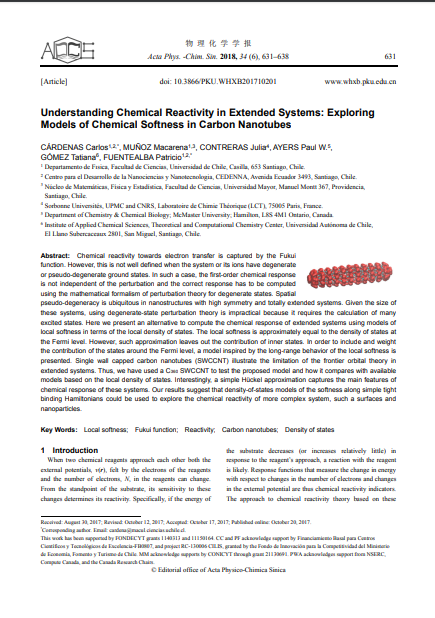Understanding Chemical Reactivity in Extended Systems: Exploring Models of Chemical Softness in Carbon Nanotubes

Fecha
2018Autor
Múñoz, Macarena [Univ Mayor, Nucleo Matemat Fis & Estadist, Fac Ciencias, Manuel Montt 367, Santiago, Chile]
Cárdenas, Carlos
Contreras, Julia
Ayers, Paul W.
Gomez, Tatiana
Fuentealba, Patricio
Ubicación geográfica
Notas
HERRAMIENTAS
Acceda a títulos restringidos
¿Cómo descargar?Resumen
Chemical reactivity towards electron transfer is captured by the Fukui function. However, this is not well defined when the system or its ions have degenerate or pseudo-degenerate ground states. In such a case, the first-order chemical response is not independent of the perturbation and the correct response has to be computed using the mathematical formalism of perturbation theory for degenerate states. Spatial pseudo-degeneracy is ubiquitous in nanostructures with high symmetry and totally extended systems. Given the size of these systems, using degenerate-state perturbation theory is impractical because it requires the calculation of many excited states. Here we present an alternative to compute the chemical response of extended systems using models of local softness in terms of the local density of states. The local softness is approximately equal to the density of states at the Fermi level. However, such approximation leaves out the contribution of inner states. In order to include and weight the contribution of the states around the Fermi level, a model inspired by the long-range behavior of the local softness is presented. Single wall capped carbon nanotubes (SWCCNT) illustrate the limitation of the frontier orbital theory in extended systems. Thus, we have used a C-360 SWCCNT to test the proposed model and how it compares with available models based on the local density of states. Interestingly, a simple Huckel approximation captures the main features of chemical response of these systems. Our results suggest that density-of-states models of the softness along simple tight binding Hamiltonians could be used to explore the chemical reactivity of more complex system, such a surfaces and nanoparticles.
Coleccion/es a la/s que pertenece:
Si usted es autor(a) de este documento y NO desea que su publicación tenga acceso público en este repositorio, por favor complete el formulario aquí.